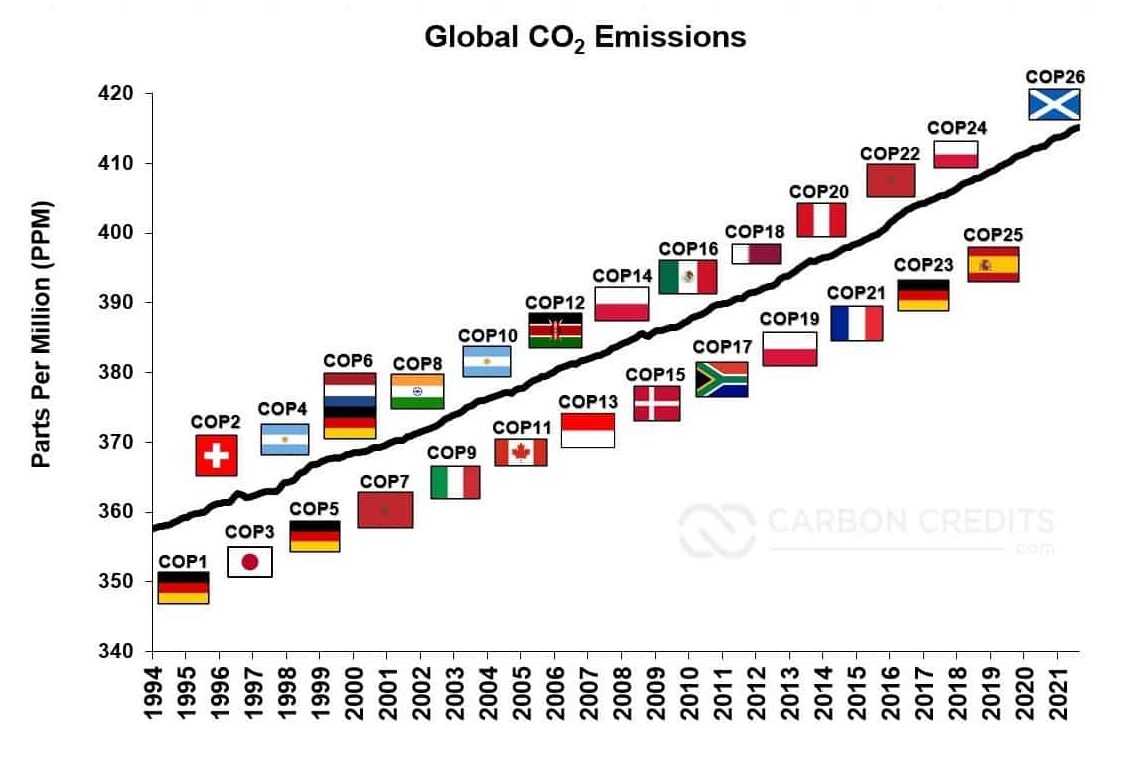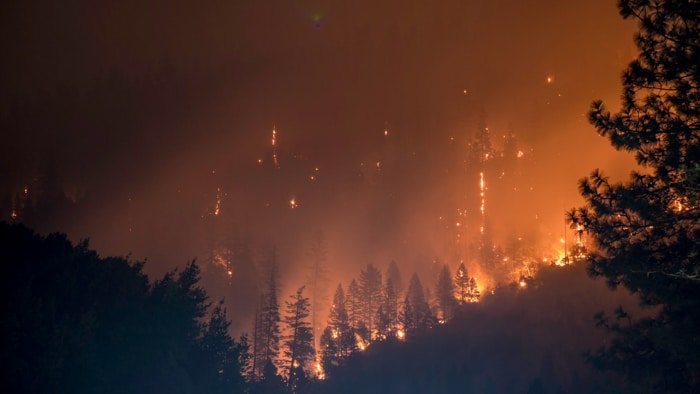
Supervising “The Mechanism”
The Conference of the Parties (COP), serving as the meeting of the Parties to the Paris Agreement (CMA), during its 3rd session held in Glasgow, made a significant decision by adopting Decision 3/CMA.3. The COP timeline is shown below, alongside the rising global carbon emissions.

The decision captures the rules, procedures, and operational framework for the mechanism established by Article 6, paragraph 4, of the Paris Agreement, commonly referred to as “the mechanism.”
In line with this decision, the CMA has appointed a Supervisory Body responsible for overseeing and administering the mechanism. It operates under the authority and guidance of the CMA.
The Supervisory Body also works with full accountability to the COP.
Comprising 12 members from Parties to the Paris Agreement, the Supervisory Body ensures a wide and fair geographical representation. Its members aim for a balanced representation, with this composition: 2 members from each of the 5 United Nations regional groups, 1 member representing the least developed countries, and 1 member representing small island developing States.
The term of service for the newly appointed members begins from the first meeting of the Supervisory Body this year.
Key Principles for Emissions Reductions & Accountability
Central to the Body’s proposed methodologies are several key principles and features of carbon projects.
For instance, the methodologies advocate for a cautious approach in estimating a project’s emission reductions or removals. This is to ensure the credibility of the credits and to promote greater ambition in emissions reduction efforts.
It involves establishing emission baselines below the scenario of business-as-usual GHG emissions that would have occurred without the carbon project.
Moreover, to uphold increasing environmental ambition, the draft suggests that the baseline should “evolve or lead to a downward adjustment of creditable emission reductions over time”.
Additionally, stakeholder involvement throughout the methodology development process and accounting for potential uncertainties associated with the underlying data are crucial aspects emphasized in the draft.
Demonstrating a project’s additionality is another pivotal requirement within each methodology. It requires an assessment showing that the project activity would not have taken place without the incentives from the mechanism. But this should consider all relevant national policies, including legislation.
Mechanism methodologies will also need to address project leakage. This refers to a change in GHG emissions outside the project boundary linked with the project’s activities.
Finally, the document touches upon non-performance and reversal aspects. These pertain to the potential reversal of emission removals or the risk that the carbon avoided or removed might not remain so for the duration of the project. An example would be a wildfire, which has been reversing the carbon removals of the trees under a carbon project.

The draft mentions the ongoing need for the supervisory body to further develop guidance in these areas.
What Comes Next?
Some market players have commented on the draft prior to its release. An accredited observer organization highlighted the need to come up with an agreed definition of “removals”. They refer to clearly identifying exact removal of greenhouse gasses (GHG) versus carbon dioxide (CO2).
The Supervisory Body responded accordingly, adopting this final definition on its recently published draft:
“Removals are the outcomes of processes to remove greenhouse gasses from the atmosphere through anthropogenic activities and durably store them…”
Others also noted that until the credits are issued under the Article 6.4 mechanism, the voluntary carbon market (VCM) remains the primary avenue for private capital investment in activities aimed at GHG mitigation or removal.
Given the timelines associated with investments in project activities and the preparatory period for project implementation, the VCM is expected to remain the predominant platform for investment. This is likely to persist until 2025,
SDGs, Targets, and Indicators
SDGs Addressed or Connected to the Issues Highlighted in the Article:
- SDG 13: Climate Action
The article discusses the methodologies for carbon reduction projects and the upcoming COP28 climate conference. These topics are directly related to SDG 13, which focuses on taking urgent action to combat climate change and its impacts.
Specific Targets Under SDG 13 Based on the Article’s Content:
- Target 13.2: Integrate climate change measures into national policies, strategies, and planning
- Target 13.3: Improve education, awareness-raising, and human and institutional capacity on climate change mitigation, adaptation, impact reduction, and early warning
- Target 13.a: Implement the commitment undertaken by developed-country parties to the United Nations Framework Convention on Climate Change to a goal of mobilizing jointly $100 billion annually by 2020 from all sources to address the needs of developing countries in the context of meaningful mitigation actions and transparency on implementation and fully operationalize the Green Climate Fund through its capitalization as soon as possible
The article mentions the development of methodologies for carbon reduction projects, which aligns with Target 13.2 as it involves integrating climate change measures into policies and planning. The focus on stakeholder involvement and addressing uncertainties also relates to Target 13.3, which emphasizes improving education and capacity on climate change mitigation. Additionally, the mention of the Green Climate Fund and financial support for developing countries connects to Target 13.a.
Indicators Mentioned or Implied in the Article:
- Emission reductions or removals
- Emission baselines
- Stakeholder involvement
- Potential uncertainties associated with data
- Additionality of project activities
- Project leakage
- Non-performance and reversal of emission removals
The article discusses various indicators related to measuring progress towards the identified targets. These indicators include emission reductions or removals, emission baselines, stakeholder involvement, uncertainties associated with data, additionality of project activities, project leakage, and non-performance and reversal of emission removals. These indicators are crucial for assessing the effectiveness and credibility of carbon reduction projects and their contribution to climate action.
Table: SDGs, Targets, and Indicators
| SDGs | Targets | Indicators |
|---|---|---|
| SDG 13: Climate Action | Target 13.2: Integrate climate change measures into national policies, strategies, and planning | Emission reductions or removals, emission baselines, stakeholder involvement, potential uncertainties associated with data |
| SDG 13: Climate Action | Target 13.3: Improve education, awareness-raising, and human and institutional capacity on climate change mitigation, adaptation, impact reduction, and early warning | Additionality of project activities, stakeholder involvement, potential uncertainties associated with data |
| Target 13.a: Implement the commitment undertaken by developed-country parties to the United Nations Framework Convention on Climate Change to a goal of mobilizing jointly $100 billion annually by 2020 from all sources to address the needs of developing countries in the context of meaningful mitigation actions and transparency on implementation and fully operationalize the Green Climate Fund through its capitalization as soon as possible | Financial support for developing countries, potential uncertainties associated with data |
Behold! This splendid article springs forth from the wellspring of knowledge, shaped by a wondrous proprietary AI technology that delved into a vast ocean of data, illuminating the path towards the Sustainable Development Goals. Remember that all rights are reserved by SDG Investors LLC, empowering us to champion progress together.
Source: carboncredits.com

Join us, as fellow seekers of change, on a transformative journey at https://sdgtalks.ai/welcome, where you can become a member and actively contribute to shaping a brighter future.






